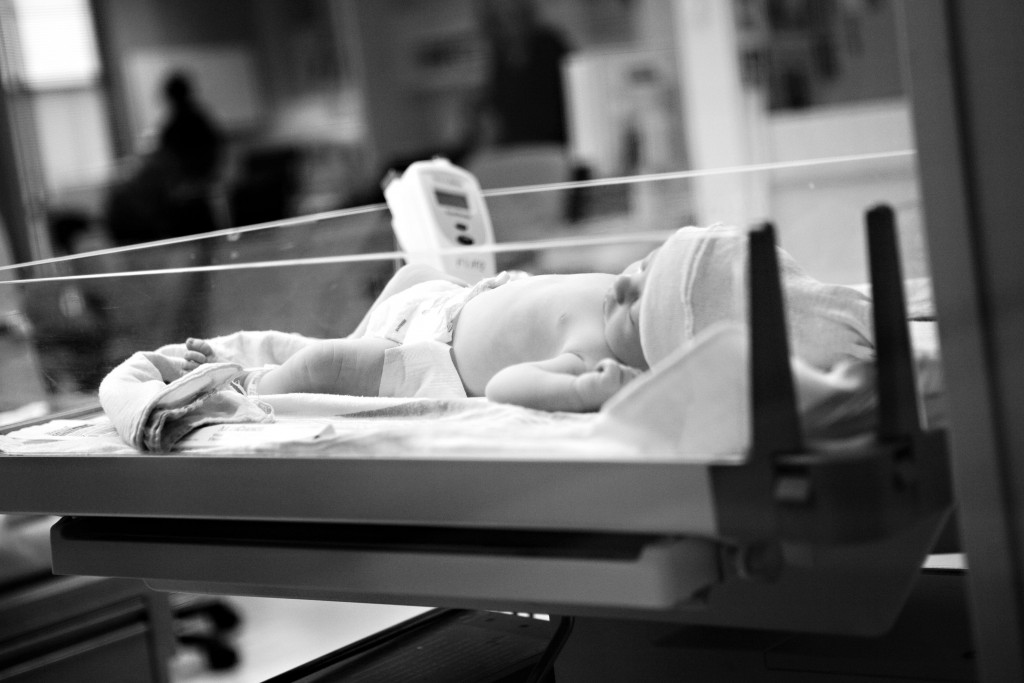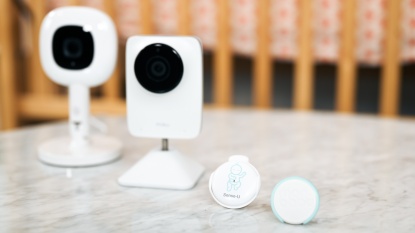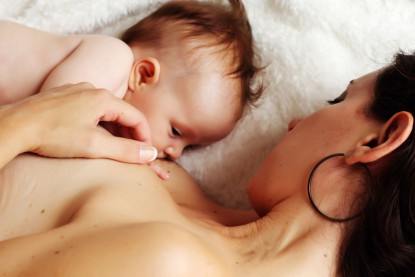The AAP (American Academy of Pediatrics) Task Force on Sudden Infant Death Syndrome issued an important updated Policy Statement in October of 2016 (from the initial 2011 statement) titled "SIDS and Other Sleep-Related Infant Deaths: Updated 2016 Recommendations for a Safe Infant Sleeping Environment".
AAP Safe Sleep Guidelines
Our hope is that you read the following safe sleep/SIDS prevention guideline recommendations and follow them point by point. They really are that important.
- Back to Sleep for Every Sleep — Every infant should be placed on their back to sleep until 1 year of age. Once infants are able to roll from their back to stomach AND from their stomach to back, they can remain in the sleep position they choose, but still always first be placed to sleep on their backs. However, immediately following birth, baby may be placed "skin-to-skin" with mother for at least an hour, provided both mother and infant are medically stable and being closely monitored. Finally, truth be told, there is no evidence that infants with reflux are at an increased risk of choking while sleeping flat on their backs.
- Baby Should Sleep on a Firm Sleep Surface, Alone — While at first blush, this may sound uninviting and cold, this is an absolutely important tenant of SIDS prevention. All babies should sleep alone on a firm, fitted mattress with a fitted sheet ONLY. Baby should not sleep with anything else in the crib except him/herself. Function trumps fashion. Full stop. This means NO cozy bedding such as blankets, quilts, sheets, and sheepskin. And, NO crib bumpers, pillows, or stuffed animals. So if you are enticed by those decorative, squishy crib bumpers at the store or online, just say no, turn the other direction, and run! Frankly, I wish they were banned from being sold. If a parent is concerned about warmth, infant sleep clothing such as a wearable blanket is appropriate. Sleep can be in a bassinet, crib, travel crib or play yard such as a pack 'n play that conforms to current CPSC s,afety standards (i.e. slates spacing less than 2 3/8", firm mattress with a snug fit to the crib, no drop sides). Babies should not share a bed with an adult; both soft mattresses and bedding as well as sleeping with an adult increase the risk of entrapment and suffocation. Similarly, in-bed sleepers are not recommended for this concern and there is no evidence that they reduce the risk of SIDS or are safe, for that matter. Lastly, a baby should never be placed to sleep on a sofa or any similar seemingly "flat" surface not specifically designed and intended for infant sleep.
- Room Sharing Without Bed Sharing — It is recommended that infants remain in the same room as parents, close to their bed, until 6 to 12 months of life, BUT ALWAYS on their own separate infant-designed sleep surface. This is now a firm recommendation with amazing evidence showing SIDS reduction by as much as 50%. The first 6 months are critical ones, although keeping a baby in the parent's room is recommended for a full 12 months, if possible. Baby's bed should be close enough so that a parent can both see the baby and easily respond to facilitate comforting monitoring, and feeding. Because the safety and benefits of twins sleeping together have not been established, providing twins and young siblings separate sleep surfaces is the safest option.
- Exclusive Breastfeeding — Breastfeeding is associated with a reduced risk of SIDS. Unless contraindicated medically, a mother should either exclusively breastfeed or give the baby her expressed breastmilk for the first six months of life, as recommended by the AAP. Though exclusive breastmilk is best, it is also true that any amount of breastfeeding is more protective than none at all.
- Pacifier Use — Although the "why" is not entirely understood, pacifier use also has been shown to have a protective effect against SIDS, even after it falls out of an infant's mouth once baby has fallen asleep! So once direct breastfeeding has been well-established, offer a pacifier to the baby when placing him/her down for both naps and bedtime. If a pacifier falls out, it does not need to be put back into the baby's mouth.
- Swaddling — While swaddling is a great tactic for soothing a fussy infant, the risk of death is high if a swaddled baby rolls from back to tummy. As such, swaddled infants should always be placed on their back. With the first sign that baby is even beginning to think about rolling over, swaddling should be discontinued. As most parents swaddle their newborn for sleep, a good Rule of Thumb is to discontinue swaddling at 8 weeks of age and replace it with an appropriately sized infant sleep sack.
- Avoid Overheating Infant — Do not overdress baby as overheating can be a risk factor for SIDS. As a general Rule of Thumb, infants should be dressed in only one layer more than that in which an adult is comfortable. If an infant feels sweaty or warm, take off a layer and reassess. And, always avoid over-bundling.
- Sitting and Soothing Devices like Swings and Babocush Are Not Recommended for Sleep — You heard it! This includes swings, rockers, bouncers, infant car seats, and baby carriers (particularly slings). Why? Because unsupervised, these can put infants in a position that places them at risk for airway obstruction and suffocation. Ever seen a baby with its chin directly on its chest without a few finger breadths separating the two? This position compromises a baby's airway which places a baby at great risk. Furthermore, when a baby is in a device with straps, let's say an infant car seat or stroller, never have baby in it unstrapped or partially strapped. This subjects baby to the risk of strangulation. What about the Babocush, you ask? This device places baby prone on its belly while it rocks baby with added vibration and heartbeat to help soothe. While it may soothe, the concern is that parents will then be overjoyed to allow their baby to sleep unsupervised on this contraption. This ignores the first tenant of SIDS prevention: Placing baby on his/her back to sleep for every sleep. Period. And, to drive this topic home, the 2011 American Academy of Pediatrics Task Force on SIDS's policy statement recommends that infants sleep in a crib, bassinet, or portable play yard with a firm mattress.
- Avoid Positioning Devices — Infant wedges and positioning devices such as in-bed sleep surfaces are not recommended for use and do not prevent SIDS. So, while it may be tempting to put your baby in that DockaTOT or Snuggle Me in the middle of your parental bed for co-sleeping, we advise you to resist!
- Be Wary of Products Marketed as "Breathable" and Monitors Marketed to Reduce the Risk of SIDS — Never substitute products such as breathable crib mattresses and breathable bumpers as well as products such as home cardiorespiratory and movement monitors as replacements for safe sleep practices; there is NO data to prove these products reduce the risk of SIDS. The only thing they can do is help to reduce parental anxiety; however, now that there is a recommendation for all infants to sleep in parent's room on a separate infant sleep surface close by to a parent for baby's first 6 to 12 months of life, a monitor may not felt to be as "needed" by parents at nighttime.
- Regular Prenatal Care — Evidence indicates that infants of mothers who receive regular prenatal care have a lower risk of SIDS.
- Avoid Smoke Exposure During Pregnancy and After Birth — This is a major risk factor for SIDS and includes exposure to second-hand smoke found in the air, in cars, and on clothing. In fact, one-third of SIDS deaths could be prevented if mothers abstained from smoking during pregnancy.
- Avoid Alcohol and Illicit Drug Use During Pregnancy and After Birth — As with smoke exposure, alcohol and drug use should be avoided, particularly in combination with bed sharing.
- Keep Baby Up-To-Date on Immunizations — Recent evidence suggests that timely immunization in accordance with the AAP and CDC schedule has a protective effect against SIDS. Although the converse is NOT true in that there is NO EVIDENCE pointing toward a causal relationship between immunization and SIDS.
- Supervised, Awake Tummy Time — In addition to minimizing the development of positional plagiocephaly, a bit of daily supervised tummy time is helpful to strengthen an infant's neck and upper body musculature.
- Ensure That All of Baby's Care Providers Understand and Practice Safe Sleep Recommendations — This includes grandparents, nannies, babysitters, daycare, and ANYONE caring for your baby at ANYTIME. Make sure they understand that these recommendations are not optional and leave no room for interpretation, even if grandma insists that she did it differently when you were a baby and you turned out fine. If she is giving you grief, show her the AAP's new video below.
Help Spread the Word on Safe Sleep
The above recommendations are specific, clear, time-tested, evidence-based, and need to be followed for baby's health and safety. Please encourage everyone to practice safe sleep recommendations with all infants.
Everyone.
Every Baby.
Everywhere.
Every Time.
For Naptime.
And
For Nighttime.
Editor's Note: The information above is sourced from the updated 2016 AAP Policy Recommendations for a Safe Sleep Environment as well as from a series of articles on SIDS and other causes of sleep-related deaths that originally appeared in the Nov 2011 issue of AAP News as well as a 2013 edition of the same.
For more information:
- HealthyChildren.org (a publication of the AAP)-- Reduce the Risk of SIDS
- National Institute for Child and Human Development — http://www.nichd.nih.gov/sts/about/Pages/default.aspx
- First Candle/SIDS Alliance — http://www.firstcandle.org
- Wikipedia — http://en.wikipedia.org/wiki/Sudden_infant_death_syndrome




